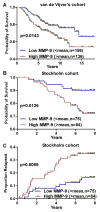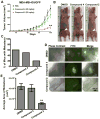Small-molecule anticancer compounds selectively target the hemopexin domain of matrix metalloproteinase-9
- PMID: 21646471
- PMCID: PMC3138841
- DOI: 10.1158/0008-5472.CAN-10-4552
Small-molecule anticancer compounds selectively target the hemopexin domain of matrix metalloproteinase-9
Erratum in
- Cancer Res. 2012 Oct 1;72(19):5141-2. Dosage error in article text
Abstract
Lack of target specificity by existing matrix metalloproteinase (MMP) inhibitors has hindered antimetastatic cancer drug discovery. Inhibitors that bind to noncatalytic sites of MMPs and disrupt protease signaling function have the potential to be more specific and selective. In this work, compounds that target the hemopexin (PEX) domain of MMP-9 were identified using an in silico docking approach and evaluated using biochemical and biological approaches. Two of the selected compounds interfere with MMP-9-mediated cancer cell migration and proliferation in cells expressing exogenous or endogenous MMP-9. Furthermore, these inhibitors do not modulate MMP-9 catalytic activity. The lead compound, N-[4-(difluoromethoxy)phenyl]-2-[(4-oxo-6-propyl-1H-pyrimidin-2-yl)sulfanyl]-acetamide, specifically binds to the PEX domain of MMP-9, but not other MMPs. This interaction between the compound and the PEX domain results in the abrogation of MMP-9 homodimerization and leads to blockage of a downstream signaling pathway required for MMP-9-mediated cell migration. In a tumor xenograft model, this pyrimidinone retarded MDA-MB-435 tumor growth and inhibited lung metastasis. Thus, we have shown for the first time that a novel small-molecule interacts specifically with the PEX domain of MMP-9 and inhibits tumor growth and metastasis by reducing cell migration and proliferation.
©2011 AACR.
Conflict of interest statement
Figures







References
-
- Deryugina EI, Quigley JP. Matrix metalloproteinases and tumor metastasis. Cancer Metastasis Rev. 2006;25:9–34. - PubMed
-
- Overall CM, Kleifeld O. Tumour microenvironment - opinion: validating matrix metalloproteinases as drug targets and anti-targets for cancer therapy. Nat Rev Cancer. 2006;6:227–39. - PubMed
Publication types
MeSH terms
Substances
Grants and funding
LinkOut - more resources
Full Text Sources
Other Literature Sources
Miscellaneous

